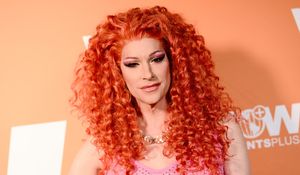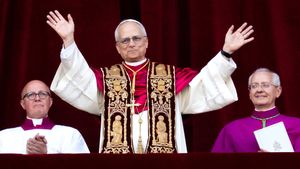Seventy years ago, the first lesbian rights organization in the U.S. was founded. It was called the Daughters of Bilitis, and it endured into the 1970s. The group may not have lasted long, but its influence has. Here are the key facts to know about the organization.
Keep up with the latest in LGBTQ+ news and politics. Sign up for The Advocate's email newsletter.
The beginnings
In 1955, eight women gathered in the San Francisco home of Rosalie “Rose” Bamberger and her partner, Rosemary Sliepen. Others present, according to the Library of Congress, were Marcia Foster and her partner, June; Noni Frey and her partner, Mary; and the best-known couple associated with the group, Del Martin and Phyllis Lyon. Their organization was named after a lesbian character in an 1894 book of poetry, The Songs of Bilitis, by Frenchman Pierre Louÿs. Side note: Louÿs claimed the poems were works by Bilitis, a lover of Sappho, and that he had discovered and translated them, but Bilitis was actually a character he invented. The book became a classic of lesbian erotica nonetheless.
The founders represented a diversity of class and ethnicity. Bamberger, who came up with the idea for the Daughters of Bilitis, was Filipina, and she and Sliepen, a white woman, were both factory workers. Mary, whose surname is lost to history, was Chicana, and she and Frey, also white, were working-class as well. The other couples were white women with white-collar jobs; Lyon and Martin, for instance, were journalists.
Martin was the group’s first president, Frey was vice president, Lyon was secretary, and Sliepen was the treasurer. Foster was a trustee.
Soon, however, tensions arose. Bamberger had conceived of the club as a private social group, but some of the other women wanted it to be public and political. The working-class women left within six months of the founding. “The goal of advocating for lesbian and gay rights was obviously an admirable one, and today’s LGBTQ movement owes a lot to early activists like Del Martin and Phyllis Lyon,” but the more middle-class women seemed to be unaware of the additional pressures on blue-collar workers and women of color, novelist Malinda Lo (Last Night at the Telegraph Club) wrote in a 2021 blog post. “Although white, middle class, cisgender lesbians certainly faced plenty of bigotry in the 1950s, those who were non-white, working class, and gender non-conforming faced additional hurdles,” Lo noted.
The working-class women formed two other, more private groups, Quatrefoil and Hale Aikane. But Bamberger and Sliepen remained on Martin and Lyon’s mailing list into the 1970s, according to the Library of Congress.
The Ladder
As the group proceeded, it founded the first nationally distributed publication for lesbians, The Ladder. the first issue came out in October 1956. Lyon was its editor, originally using the pseudonym Ann Ferguson. The initial issue detailed the Daughters of Bilitis’s mission and invited members, saying heterosexuals were welcome if they understood the issues faced by sexual minorities. A message from Martin, as president, noted that other groups for gays and lesbians, such as the Mattachine Society, One, and the National Association for Sexual Research, “are predominantly male, although there are a few hard working women among their ranks,”
“The Daughters of Bilitis is a women’s organization resolved to add the feminine voice and viewpoint to a mutual problem,” Martin continued. “While women may not have so much difficulty with law enforcement, their problems are none the less real — family, sometimes children, employment, social acceptance.” Martin pointed out the progress women had made in the 20th century and encouraged lesbians to band together and be what is now called “out and proud.”
The debut issue also offered a calendar of events, a positive review of the play Tea and Sympathy, and a briefer but likewise positive review of a film adaptation of Radclyffe Hall’s lesbian novel The Well of Loneliness. The film is now apparently lost. The issue further reported on efforts to compile a bibliography of lesbian books and asked readers to send in any of their books that were simply gathering dust. It went on to say the staffers would like to hear from any readers who might want to participate in research studies.
It concluded with a tribute to sexologist Alfred Kinsey, who died in August 1956 after doing much to expand the understanding of sexuality and its variations. The Ladder reprinted a letter to the editor that had been published in the San Francisco Examiner, calling Kinsey “an outstanding scientist and a champion of human freedom and happiness.”
The first issue is posted at a website called Alexander Street. Several other sites have digitized some issues as well; find them in the Library of Congress post.
In its early years, The Ladder’s covers featured illustrations, but as more lesbians became comfortable with being out, the covers had photographs. The first Black woman on the cover was Ernestine Eckstein, pictured on the front of the June 1966 issue, in which she was interviewed. “Any movement needs a certain number of courageous people, there’s no getting around it,” she said at the time.
The Ladder ended publication in 1972, “following the 1970 secret takeover of the magazine by its editor, Barbara Grier, and the DOB national president at the time, Rita LaPorte, both of whom favoured a stronger lesbian feminist stance than that which the DOB generally advocated,” according to Encyclopedia Britannica. That reflected tensions within the organization over whether to work with groups that included men or to take a separatist approach.
Expansion and new chapters
By 1960, there were Daughters of Bilitis chapters in Rhode Island, New York, Chicago, and Los Angeles. Legendary activist Barbara Gittings formed the New York chapter in 1958, two years after she met Lyon and Martin. Gittings edited The Ladder from 1960 to 1963 and was behind the move the replace the cover illustrations with photos, many taken by her partner, Kay Tobin Lahusen.
Gittings also pushed the organization and the gay and lesbian rights movement in a more activist direction. “In 1965, she joined the pioneers who participated in the first wave of public gay pickets at the White House, at the Pentagon and at Independence Hall in Philadelphia, Tracy Baim wrote in her 2015 book Barbara Gittings, Gay Pioneer. Eckstein, who was vice president of the New York chapter, joined in the White House protest as well; she was the only Black woman in Lahusen’s famed photograph of the demonstration. Eckstein was active in the Black civli rights movement the Black feminist movement too, and she and Gittings joined in the Fourth of July "Reminder Day" marches held at Independence Hall for several years.
Gittings and Lahusen were later involved in the successful effort to convince the American Psychiatric Association to remove homosexuality from its list of mental disorders, which the APA did in 1973. Gittings died in 2007, Lahusen in 2021. Eckstein died at age 51 in 1992, and little is known of her later life.
The end and the afterlife
The Daughters of Bilitis ceased being a national organization in the 1970s, but some chapters carried on for several more years. Its leaders moved on to other groups. In 1973, Gittings was a founding member of the National Gay Task Force (now the National LGBTQ Task Force). Martin and Lyon were active in San Francisco's Alice B. Toklas Democratic Club, which helped persuade Dianne Feinstein, when she was mayor of the city, to sponsor legislation outlawing employment discrimination against gays and lesbians. They also fought for the decriminalization of homosexuality in California and were the first lesbian couple to join the National Organization for Women. In 2004, when Gavin Newsom, then mayor of San Francisco, declared marriage equality in the city, they were the first same-sex couple to receive a license. Courts later made the city cease performing same-sex marriages and invalidated the unions.
Martin and Lyon were among the couples who sued for equal marriage rights in the case that led the California Supreme Court to strike down the state’s ban on same-sex marriage in 2008. They became one of the two first same-sex couples to marry legally in California — Martin and Lyon wed in San Francisco, Robin Tyler and Diane Olson in Los Angeles. The weddings took place in June, and Martin died in August, at age 87. Proposition 8, passed by voters in November of that year, temporarily revoked marriage equality in the Golden State, but Lyon lived long enough to see it struck down for good in 2013 and to see the U.S. Supreme Court to rule for nationwide marriage equality in 2015.
Martin and Lyon were the first out lesbians to join the National Organization for Women, which in its early years saw tension over the inclusion of lesbians, something for which the couple advocated. In 1995, they were named delegates to the White House Conference on Aging.
Lyon’s other achievements included cofounding the National Sex Forum, where she was a director for 19 years, and working as a professor at the Institute for Advanced Study of Human Sexuality. She and Martin also collaborated on the 1972 book Lesbian/Woman. Lyon died in 2020 at age 95.
The Daughters of Bilitis “facilitated one of the first opportunities for lesbians to meet and share their everyday struggles” and “began the long quest to achieve visibility and acceptance for lesbians and to place lesbian rights on the civil rights agenda,” the Britannica entry concludes.













































































